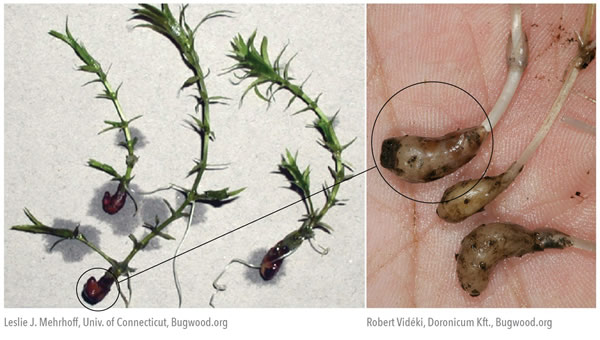Hydrilla (Hydrilla verticillata) is a highly invasive submersed aquatic plant introduced from Asia to the United States. There are two biotypes of hydrilla in the United States: the dioecious biotype was introduced from Sri Lanka into Florida in the 1950s and has spread throughout the southeastern United States, and the monoecious biotype was first discovered in Delaware in 1976 and has since spread through the Atlantic states and in several of the Great Lakes states. Thus, the focus of the collaborative is on the monoecious biotype.
Hydrilla is one of the world’s most invasive aquatic plants and it possesses several characteristics that allow it to spread rapidly, displace other aquatic plants, and form dense single-species infestations:
-
Hydrilla can reproduce in four ways: tubers, turions, fragmentation, and seeds. The first three mechanisms are asexual and are the primary means by which hydrilla expands into new environments and regrows after exposure to adverse environmental conditions.
- Tubers are potato-like structures produced below the sediment surface that are viable for years, allowing the plant to regrow at a given location when all aboveground parts of the plant are destroyed.
- Turions are compact dormant buds produced by the above-sediment portion of the plant. When fully formed, they are released from the parent plant and are carried downstream by water currents, or settle to the surrounding sediment to grow.
- Fragmentation is a process in which nodes of the parent plant break away into buoyant fragments that disperse through the system by water currents. Fragmentation occurs naturally due to wave action and currents. Anthropogenic activities, such as boating, can increase fragmentation and transport plant fragments to other water bodies.
- Hydrilla can absorb nutrients from water and sediment. This ability allows plant fragments to remain viable and grow while floating in the water column.
- Hydrilla can photosynthesize and grow under low light levels, giving it a competitive advantage over other aquatic plants in the same environment.
- Hydrilla grows rapidly compared with many native aquatic plants, allowing it to displace native species.

How to Identify Hydrilla?
- Pointed, bright green leaves about 5/8 inch (1-2 cm) long with small teeth on the edges
- Leaves generally grow in whorls of three to 10 around the stem, though five leaves are most common
- Floating white flowers and small white to yellowish potato-like tubers attached to the roots


